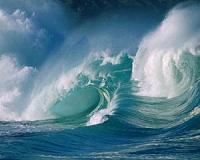 |
Washington DC (SPX) Sep 21, 2010 The nation's ability to detect and forecast tsunamis has improved since the 2004 Indian Ocean tsunami, but current efforts are still not sufficient to meet challenges posed by tsunamis generated near land that leave little time for warning, says a new congressionally requested report from the National Research Council. The report calls for a comprehensive national assessment of tsunami risk and improved communication and coordination among the two federal Tsunami Warning Centers, emergency managers, media, and the public. "For a tsunami warning system to be effective, it must operate flawlessly, and emergency officials must coordinate seamlessly and communicate clearly," said John Orcutt, chair of the committee that wrote the report and a professor at the Cecil H. and Ida M. Green Institute of Geophysics and Planetary Physics at Scripps Institution of Oceanography in La Jolla, Calif. "However, if a large earthquake near shore triggers a tsunami, it could reach the coast within minutes, allowing hardly any time to disseminate warnings and for the public to react. Education and preparation are necessary to ensure that people know how to recognize natural cues - such as earthquake tremors or receding of the water line - and take appropriate action, even if they do not receive an official warning." At the request of Congress for a review of the nation's tsunami efforts, the report finds many enhancements have been made since 2004, including an increase in the amount and quality of hazard and evacuations maps and the expansion of the Deep-Ocean Assessment and Reporting of Tsunamis (DART) sensor network that indicates the size of tsunamis. There have also been improvements in coastal sea-level stations and the Global Seismic Network operated and maintained by the U.S. Geological Survey and the National Science Foundation. Moreover, various states have evaluated select tsunami-prone communities and initiated several tsunami education and awareness efforts. However, improvements to the DART network's reliability, station coverage, and operations are needed. In addition to expanding detection and forecasting, an ideal and comprehensive tsunami program will require risk assessments, public education, and a well-coordinated response, the committee concluded. Persistent progress in these areas will be needed. To gauge how to prioritize efforts, the report recommends first completing a comprehensive risk assessment that characterizes the hazards, inventories the threatened populations and assets, measures the preparedness and ability of individuals and communities to successfully evacuate, and estimates expected losses. Tsunami education and preparation could also be improved by undertaking periodic and comprehensive vulnerability assessments, establishing a review strategy and leadership chain for post-tsunami events, and creating new tsunami detection techniques and analyses.
Improving Warning Messages and Coordination Operating under the National Oceanic and Atmospheric Administration's National Weather Service, the TWCs monitor seismic activity and sea levels to detect tsunamis and warn emergency managers in their respective regional "areas of responsibility." However, even though the TWCs issue the warning messages, they cannot order evacuations because they are part of the federal government. Rather, local officials are responsible for transmitting alerts throughout their respective jurisdictions, issuing evacuation orders, managing evacuations, and declaring all-clears. Therefore, close coordination between the TWCs, states, and local jurisdictions is needed to ensure that the public receives consistent information about the threat and proper protective action. Although multiple, consistent tsunami warning messages increase public responsiveness, the organizational model of two TWCs is problematic because the two sets of warnings often conflict, causing confusion among the media, some local officials, and the public. For example, in June 2005, media outlets in the Pacific Northwest received messages from both TWCs that seemingly contradicted each other because their respective areas of responsibility were not understood. The committee recommended that the message content be improved or that the two TWCs release one message that includes information for all areas under their responsibility. The TWCs are also designed to be backups for each other, but they do not operate as such, creating an illusion of redundancy that could prove dangerous and costly, the report says. Significant changes need to occur in the management, operations, software and hardware architecture, and organizational culture for the two to become functionally redundant. Additionally, the committee recommended that as part of the long-range planning efforts, the TWC organizational structure should be evaluated - including deciding whether multiple TWCs should issue a single message or a single, centrally managed center should be created, such as the Hurricane Center.
Share This Article With Planet Earth
Related Links National Academy of Sciences Bringing Order To A World Of Disasters When the Earth Quakes A world of storm and tempest
 Massive waves wipe out over 40 Liberian homes
Massive waves wipe out over 40 Liberian homesMonrovia (AFP) Sept 7, 2010 Liberians began picking up the debris from their collapsed homes Tuesday after massive waves left 300 people homeless and destroyed over 40 dwellings in a shantytown near the shore in Monrovia. "The sea came in with force and took away almost everything I had in my room," resident James Thomas told AFP under a heavy downpour of rain on Monday. "There was no way for us to do anything becau ... read more |
|
| The content herein, unless otherwise known to be public domain, are Copyright 1995-2010 - SpaceDaily. AFP and UPI Wire Stories are copyright Agence France-Presse and United Press International. ESA Portal Reports are copyright European Space Agency. All NASA sourced material is public domain. Additional copyrights may apply in whole or part to other bona fide parties. Advertising does not imply endorsement,agreement or approval of any opinions, statements or information provided by SpaceDaily on any Web page published or hosted by SpaceDaily. Privacy Statement |